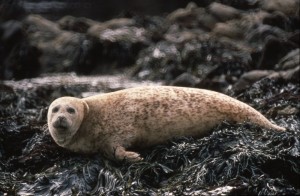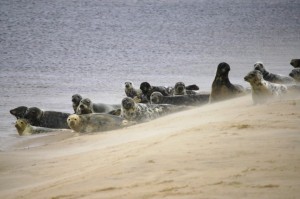Species profile – Common seal (Phoca vitulina)
At low tide the mudflats of Montrose Basin are a safe haven for between 10-20 seals each day. The seals, which are almost always common seals, also known as harbour seals, remain in familiar haul-out spots where they bask in the sun and land predators cannot reach them.
A member of the pinniped family which also includes walruses and sea lions, the common seal is the smaller of the two breeding seals in Great Britain; the other being the grey seal. We do occasionally see grey seals in the Basin, but they are much less familiar sight on the reserve than their smaller cousin.
Common seals vary in colour from brownish/black to grey with a pattern of fine, dark spots and have characteristic v-shaped nostrils.

Females, known as cows, weigh around 100kg and can live for up to 30 years old and males, or bulls, although heavier (120kg), typically only live to 20 years. One possible suggestion for this lower life expectancy is a result of the stresses the male seals encounter during the breeding season.
Common seal pups which are born in June or July weigh around 10kg at birth and can swim almost immediately. Suckling on their mother’s fat-rich milk for around three to four weeks they can double their weight by the time of weaning.
Using their sensitive whiskers to detect prey in murky waters, common seals can hold their breath for up to 10 minutes when searching for food which can include a variety of fish, squid, whelks, crabs and mussels. Fishing trips to sea can last for several days and common seals can travel up to 30-40 miles in search of a meal.
At Montrose Basin seals can sometimes be seen in the main river channel near Old Montrose Pier and they have been recorded as far upstream as Kinnaird Park near Brechin but the majority of the time they are to be found on the large sand banks at the eastern end of the Basin and the Visitor Centre offers fantastic views of these wonderful marine mammals.

Adam – Montrose Basin Ranger
Help protect Scotland’s wildlife
Our work to save Scotland’s wildlife is made possible thanks to the generosity of our members and supporters.
Join today from just £3 a month to help protect the species you love.
Preface
At low tide the mudflats of Montrose Basin are a safe haven for between 10-20 seals each day. The seals, which are almost always common seals, also known as harbour …
